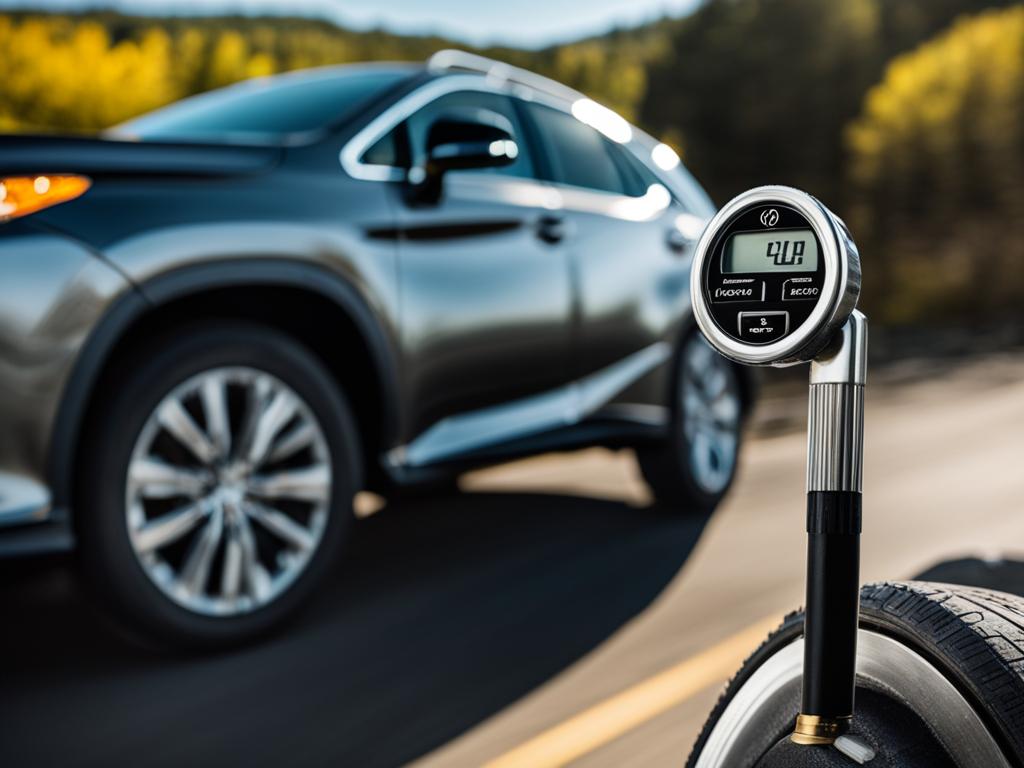Lexus RX 350 Tire Pressure Guide & Tips
Keeping the correct tire pressure in a Lexus RX 350 is crucial for vehicle safety, performance, and driving efficiency. Tire pressure impacts maneuverability, stability, and can reduce the risk of punctures by keeping tire temperature low. Fuel consumption is decreased when the tires are at the optimal pressure, thanks to reduced rolling resistance. Additionally, the correct tire pressure reduces tire wear, extends tire lifespan, and provides a smoother driving experience by improving shock absorbency.
Key Takeaways
- Maintaining proper Lexus RX 350 tire pressure is essential for safety, performance, and efficiency.
- Check the tire pressure chart on your vehicle for recommended pressures based on load and tire size.
- Opt for the correct unit of measurement on your pressure gauge according to the vehicle’s chart.
- The Tire Pressure Monitoring System (TPMS) helps detect low tire pressure and improves overall driving safety.
- Optimal tire pressure enhances performance by ensuring better handling, stability, and reduced risk of tire damage.
- Seasonal adjustments may be necessary to maintain the correct pressure, especially during colder temperatures.
- Regular tire pressure checks offer long-term benefits like increased tire lifespan and consistent fuel economy.
Understanding Your Lexus RX 350 Tire Pressure Requirements
Knowing the required tire pressure for your Lexus RX 350 will help maintain safety and performance on the road. To interpret your vehicle’s tire pressure requirements, you can refer to a tire pressure chart often found on the driver’s door frame, fuel-charger lid, or sun shield. The chart details the recommended pressure for front and rear tires, as well as the spare tire, which may differ based on size and required pressure.
Interpreting the Tire Pressure Chart
The Lexus RX 350 tire pressure chart provides model-specific recommendations for the front and rear tires based on vehicle load. The chart may use different tire pressure unit measurements, such as psi, bar, or Kpa, depending on the car’s country of origin. When checking your tire pressure, it is crucial to match the measurement unit on your gauge with the unit specified in the vehicle’s chart to ensure an accurate interpretation.
Recommended Pressure for Different RX 350 Models
Following the Lexus RX 350 recommended tire pressure varies based on the model year. Since 2016, the recommended tire pressure is typically 33 psi. However, models from 2010 to 2015 suggested 32 psi, and pre-2010 models recommended 30 psi. Tire pressure may vary slightly based on tire size, and during winter, it is advisable to inflate tires 3 to 5 psi above the specified recommendation due to colder temperatures.
Identifying the Correct Unit of Measurement
Tire pressure requirements for different RX 350s are indicated in various ways because of the differences in manufacturing countries. Ensure you understand the unit of measurement specified on your vehicle’s tire pressure chart, which could be in psi, bar, or Kpa. Always use a pressure gauge that matches the tire pressure unit measurement specified on the vehicle’s chart to accurately maintain your Lexus RX 350’s tire pressure and uphold peak driving performance.
Lexus RX 350 Tire Pressure Monitoring System Explained
The Tire Pressure Monitoring System (TPMS) is an essential feature in a Lexus RX 350, ensuring the correct tire pressure is maintained for optimal vehicle safety and performance. The system utilizes Lexus RX 350 tire pressure sensors to monitor tire pressure and alert the driver when pressure drops below the recommended range. In this section, we’ll discuss the TPMS benefits and how to reset the Lexus RX 350 tire pressure light.
The Importance of Tire Pressure Sensors
Maintaining proper tire pressure is crucial for preventing uneven tire wear and enhancing vehicle safety and fuel economy. When the tire pressure sensors in the Lexus RX 350 detect low pressure, they trigger a warning light on the dashboard as a reminder for the driver to check and adjust tire pressure as needed. This early detection system helps drivers avoid potential risks or damages due to low tire pressure.

How to Reset the Lexus RX 350 Tire Pressure Light
Resetting the TPMS light may become necessary once the correct tire pressure has been restored or after performing tire rotation or replacement. To reset the Lexus RX 350 tire pressure light, follow these simple steps for models before 2016:
- Ensure all tires, including the spare, are inflated to the correct pressure.
- Turn the ignition on without starting the engine.
- Locate the TPMS reset button near the steering wheel; it may have a tire symbol or be labeled “SET.”
- Press and hold the reset button until the TPMS warning light flashes.
- Wait a few minutes for the system to recalibrate.
- Start the engine to confirm the reset worked; if not, repeat the process.
Following these steps should enable you to reset the TPMS light in the Lexus RX 350, ensuring your tires are constantly monitored for optimal performance and safety.
Optimal Lexus RX 350 Tire Pressure for Enhanced Performance
Operating your Lexus RX 350 with the optimal tire pressure can significantly enhance driving performance. Correct inflation leads to better handling, stable maneuvering, reduced braking distances, and a lower risk of tire damage. Adjustments may be necessary for different driving conditions like off-roading in sand, where lower pressure improves traction.
It is essential to understand the optimal tire inflation for various conditions to ensure maximum Lexus RX 350 tire pressure performance. The table below provides some recommended adjustments for specific driving circumstances:
| Driving Condition | Recommended Tire Pressure Adjustment |
|---|---|
| Highway Driving | Follow standard recommended tire pressure (32-33 psi) |
| City Driving | Follow standard recommended tire pressure (32-33 psi) |
| Off-Roading in Sand | Decrease tire pressure by 10-15 psi |
| Winter Driving | Inflate tires 3 to 5 psi above the standard recommendation |
Always refer to the vehicle’s tire pressure chart and owner’s manual for specific guidance on Lexus RX 350 recommended tire pressure. However, it is crucial to note that these adjustments should be made with caution, as too high or too low tire pressure can negatively impact vehicle safety, performance, and fuel efficiency.
Regular tire pressure checks help maintain optimal tire inflation, ensuring peak Lexus RX 350 tire pressure performance.
Check your tire pressure at least once a month or before long trips, and make adjustments as necessary to keep your Lexus RX 350 operating at its best for various driving conditions. With optimal tire inflation, you can achieve superior on-road performance while maintaining safety and efficiency.
Lexus RX 350 Tire Pressure Fluctuation and Seasonal Adjustments

Tire pressure in the Lexus RX 350 can fluctuate with seasonal temperature changes. Cold weather causes pressure to drop, necessitating a higher inflation level to maintain the recommended pressure, typically 3 to 5 psi more than the standard recommendation. Regular checks are essential, especially before long trips or during significant temperature changes.
Keep in mind that seasonal tire pressure adjustment is not limited to winter. Hot weather can increase tire pressure, which also requires monitoring and potential adjustments to ensure optimal performance and safety.
Remember that the range of acceptable tire pressure varies depending on the RX 350 model and the country of origin. Always refer to the manufacturer’s recommendation for optimal tire pressure.
To make tire pressure monitoring easier, you can follow these simple tips:
- Check tire pressure at least once a month.
- Perform checks before starting a long trip.
- Check the PSI when your tires are cold, either in the morning, or after the car has been sitting idle for three or more hours.
- Monitor tires for visible damage or uneven wear that may indicate improper inflation.
Seasonal tire pressure adjustment is essential for maintaining the performance, safety, and longevity of your Lexus RX 350’s tires.
| Season | Average Temperature | Tire Pressure Adjustment |
|---|---|---|
| Winter | Below 40°F | +3 to +5 PSI |
| Summer | Above 80°F | Monitor closely and adjust as necessary |
| Spring & Autumn | Moderate Range | No significant adjustments needed |
By staying vigilant and consistently adjusting your Lexus RX 350 tire pressure to account for seasonal fluctuations, you can ensure an enjoyable driving experience, extend the life of your tires, and maintain optimal vehicle performance all year round.
Conclusion
Maintaining proper tire pressure for your Lexus RX 350 is crucial to ensure safety and efficiency on the road. Not only does it prevent rapid tire wear and lengthen tire lifespan, but it also allows the vehicle to operate smoothly and at peak performance. In this section, we will discuss the importance of regular tire pressure checks and the long-term benefits they offer.
Maintaining Proper Tire Pressure for Safety and Efficiency
Safe tire pressure maintenance plays a significant role in the overall performance of your Lexus RX 350. Adhering to the manufacturer’s recommended tire pressure guidelines ensures efficient tire pressure, allowing for optimal driving experiences and reliable vehicle safety. As a result, you can enjoy fuel efficiency, increased tire lifespan, and better driving stability.
Long-term Benefits of Regular Tire Pressure Checks
Performing regular tire pressure checks on your Lexus RX 350 has numerous long-term advantages. These include sustained tire integrity, fewer tire replacements, and consistent fuel economy. It is recommended to check tire pressure at least once a month or before long drives and always when the vehicle has been idle and the tires are cold for accurate readings. By incorporating this practice into your regular vehicle maintenance, you can secure the longevity and performance of your Lexus RX 350 and get the most out of your driving experience.
FAQ
What is the recommended tire pressure for Lexus RX 350 models?
The recommended tire pressure typically stands at 33 psi since 2016. However, from 2010 to 2015, it was 32 psi, and pre-2010 models suggested 30 psi. Slight variations may occur depending on tire size.
How do I interpret the tire pressure chart on my Lexus RX 350?
You can find the tire pressure chart on the driver’s door frame, fuel-charger lid, or sun shield. This chart details the pressure for front and rear tires based on vehicle load and includes recommendations for the spare tire, which may differ in size and required pressure.
How do I reset the Lexus RX 350 tire pressure light?
To reset the TPMS light, ensure all tires are at the correct pressure. For models before 2016, turn the car on without starting the engine, press the TPMS reset button near the steering wheel until the light flashes, and wait a few minutes for recalibration.
How does maintaining proper tire pressure enhance the performance of my Lexus RX 350?
Correct tire pressure leads to improved handling, stable maneuvering, reduced braking distances, and a lower risk of tire damage. Adjustments may be necessary for different driving conditions, such as off-roading in sand, where lower pressure improves traction.
How should I adjust my Lexus RX 350 tire pressure during cold weather?
In cold weather, you should inflate your tires 3 to 5 psi above the recommended pressure to account for lower temperatures causing a drop in tire pressure.
How often should I check my Lexus RX 350 tire pressure?
It’s recommended to check tire pressure monthly or before long drives, and always after the vehicle has been idle and tires are cold for accurate readings.
What are the long-term benefits of maintaining proper tire pressure in my Lexus RX 350?
Regular tire pressure checks yield long-term benefits, including sustained tire integrity, fewer replacements, and consistent fuel economy.




